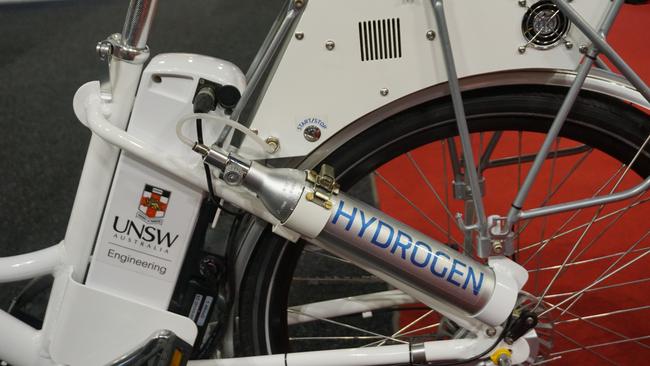From hy-cycling to self-sailing: CeBIT technology fair has it all
This Sydney technology fair has it all, from ideas seeking investors to market-ready products.
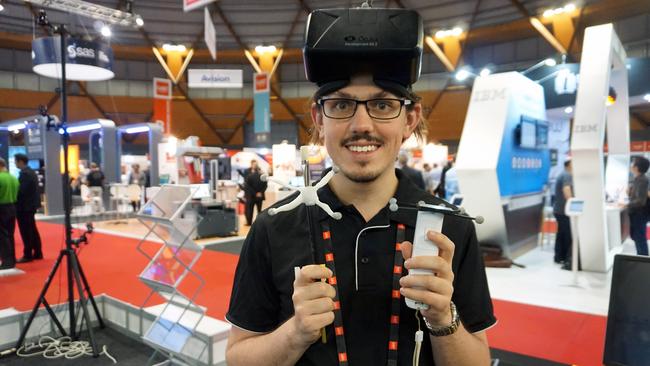
A cup of water, a dash of oxygen from the air, and a modicum of power: That will get you 100-150km on a hydrogen-powered bicycle being developed at the University of NSW.
Known as a hy-cycle, the project has been around for a couple of years, but it’s getting closer to the day when you or I can get our feet in the pedals.
Indeed it needs to happen quickly, as the French already have a similar unit in market called the Alpha bike. According to reports, France’s post office is snapping them up post haste. Research rivalry is a fact of life.
Nicholas Loeve, a PhD student at the University of NSW, hopes the Australian version will be up and running with local funding or a partnership with a local electric bike company.
Loeve was spruiking the bike at the CeBIT Australia technology fair at Sydney’s Olympic Park this week. As well as demonstrating clever research and inventions, the fair is a golden opportunity for angel investors to hunt down fledgling opportunities.
This year’s CeBIT Australia again included a start-up conference and PitchFest, where start-ups pitch business ideas to a panel of judges.
Elsewhere at the fair, firms are busy forging deals with an array of software development companies from locations such as India, The Philippines and, this year, Pakistan.
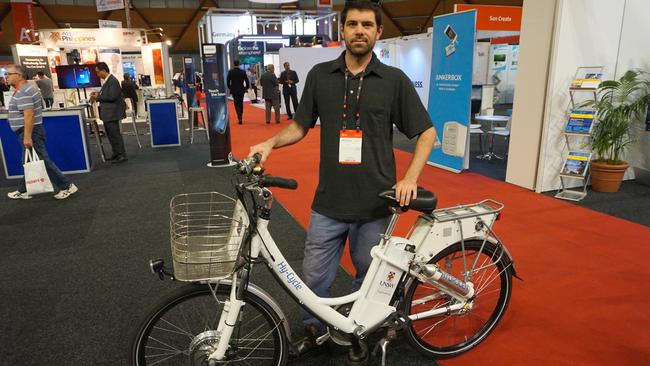
Back to the hydrogen bike. Loeve says that if second-generation development goes to plan, a hydrogen-powered bike kit will cost about $200. That’s additional to, say, the $1700 you might pay for an electric bike with motor. That’s the cost of his.
Hydrogen fuel cells create electricity that tops up a battery attached to an electric motor.
The University of NSW bike has a canister containing a metal alloy that absorbs 100-150 litres of hydrogen gas, an equivalent to the hydrogen in a bottle of water.
The canister takes about 30 minutes to fill and the fuel cell continuously tops up the electric motor’s battery as you ride along.
Loeve said the university was developing a second prototype, which would include a home electrolyser.
People could pour in a cup of water, switch on the power and it would generate the hydrogen taking in oxygen from the air. The bike would travel at 35km/hr, with a range of 120-150km from a full canister, depending on how much pedalling you do.
The current prototype uses a 200-watt electric motor and the canister takes about 20 minutes to fill.
Across at the Eveeh (electric vehicle) CeBIT stand, the pursuit is more of a golden business opportunity. The start-up is run by Slava Kozlovskii, a young Russian engineer from St Petersburg now living in Australia.
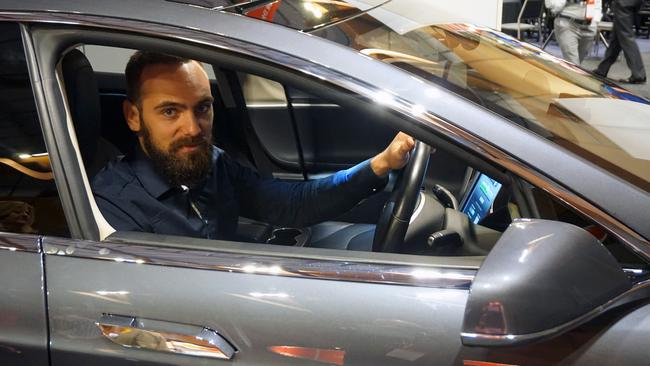
After studying business at the University of Technology Sydney, he set up a company that specialises in hiring out 100 per cent electric cars for longer-distance trips.
At the moment, that equates to a semi-autonomous $130,000 Tesla Model S. Because of the sparsity of fast chargers, it’s available only for a fixed run from Sydney to Canberra and/or return.
Kozlovskii would happily rent out other makes once they have a long-enough range. But it means that a family or a group of businesspeople can experience the relaxation of semi-autonomous driving for just $280 per carload one way.
Kozlovskii says that, in theory, you could drive autonomously for 95 per cent of the trip, but the law requires that you have your hands on the wheel.
It’s purely a commuting trip and you have to travel via Goulburn for a supercharge for 30 minutes along the way. Insurance requirements mean that you must be aged at least 30, and have two years’ experience behind the wheel.
Recharging remains the issue with full electric cars. Kozlovskii said if you simply plugged the Tesla into a power point, it would charge at 10-15km/hr, at best 24 hours for a 360km full range. There were now “destination chargers” at some hotels and restaurants offering 40-50km/hr, so seven hours for a full charge there. Tesla’s superchargers take about 75 minutes.
Kozlovskii sees a future in hire-car commuter trips and his next project is to offer the Sydney to Melbourne route, where there is already a supercharger network.
Over at the University of Newcastle stand, they’ve been showing off an autonomous boat. If you imagined the roads of the future carrying self-driving cars, the same will apply to ships on the seven seas. Boats will be buzzing around by themselves.
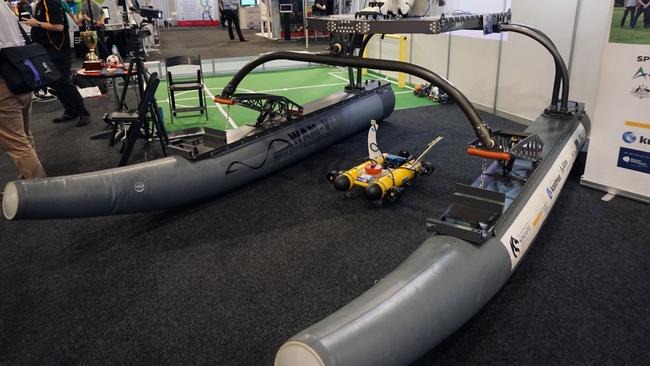
The university is preparing its autonomous boat for this year’s Maritime Robotx Challenge in Hawaii. Boats are tasked with getting from point A to point B by GPS, but are programmed to avoid obstacles and to pursue challenges such as finding coral on the sea floor or autonomously docking.
This technology may not lead to your cruiseliner crisscrossing the globe without a captain, but according to PhD student and Robotx team leader Mark Gibson, we may see autonomous boats and submarines inspecting and fixing telecommunication cables.
Already, a US Department of Defence agency called DARPA is testing an autonomous hunting boat capable of tracking submarines for months without anyone aboard. We could soon enter the age of machine-to-machine naval warfare.
Students at Newcastle also have found a niche in the burgeoning virtual-reality market.
Newcastle, known for its world-beating soccer NUbots, has developed VR “middleware” that lets handheld sensors made by one manufacturer work with a VR headset made by another.
We all hate it when gear that we buy for a MacBook doesn’t work with a PC and visa versa, so if the work of PhD student Jake Fountain can spare us the same frustrating incompatibility issues in the new VR market, it will be popular.
Fountain rigged up a system that let me paint in virtual space with a traditional paint palette in one hand and an ordinary paint brush in the other. I’ve experienced using something similar: Google Tilt Brush with an HTC Vive headset, but not with an Oculus Rift headset and a real paint brush.
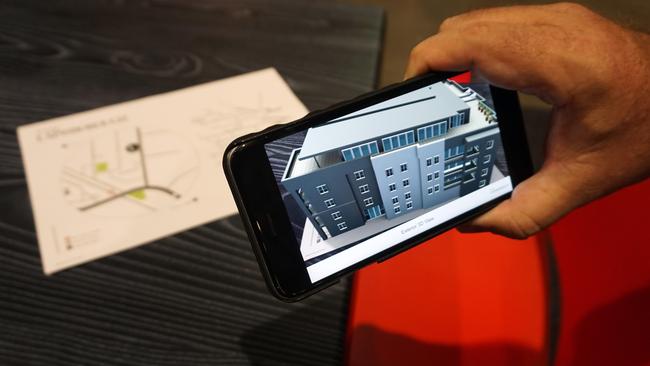
The brush contained markings that could be read by an Oculus Rift camera. The headset is made by Oculus VR which is owned by Facebook. The handheld sensor was a Nintendo Wii controller.
The firm Virtual Reality Ventures, meanwhile, was showing off IKEA’s new virtual shopping experience. I donned an HTC Vive headset and instantly changed the panel colours of a virtual kitchen several times. Using hand controllers, I also opened and closed the kitchen’s virtual drawers.
Virtual Reality Ventures is one of many companies seeking commercial opportunity in the VR world. It develops custom VR content for clients.
Another VR oriented firm, Auggd, creates augmented reality apps and software triggers for its clients so that when a customer views a brochure of a floor plan, pointing your phone at it displays the whole apartment building in 3D.
Alternatively, you could use a green screen to create a small video of yourself that pops up as a mini-figure when a customer visits your app from their phone.
Chief executive Robert Lang cited an example of an artist popping up and explaining the rationale of their painting when you point your phone at it in a museum.
The recent stints of Lang, a computer veteran, include being a board member at Capital Market Technologies and a regional manager for Nasdaq in Australia.
CeBIT Australia is due to return to Darling Harbour next year, in the new International Convention Centre.
